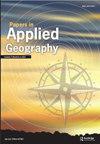Deriving Land and Water Surface Elevations in the Northeastern Yucatán Peninsula Using PPK GPS and UAV-Based Structure from Motion
Q2 Social Sciences
引用次数: 5
Abstract
Abstract While UAV-based imaging methods such as drone lidar scanning (DLS) and Structure from Motion (SfM) are now widely used in geographic research, accurate water surface elevation (WSE) measurement remains a difficult problem, as water absorbs wavelengths commonly used for lidar and SfM feature matching fails on these dynamic surfaces. We present a methodology for measuring WSE in a particularly challenging environment, the Yucatán Peninsula, where cenotes – exposed, water-filled sinkholes – provide an observation point into the critically important regional groundwater supply. In the northeastern Yucatán, elevations are very close to sea level, the area is of low relief, and the near-vertical edges of the walls of the cenotes complicate the use of the so-called “water edge” technique for WSE measurement. We demonstrate how post-processing kinematic (PPK) correction of even a single Real Time Kinematic (RTK) Global Positioning System (GPS) unit can be used to finely register the SfM-derived point cloud, and present evidence from both simulations and an empirical study that quantify the effect of “dip” in SfM-based environmental reconstructions. Finally, we present a statistical analysis of the problem of “thick” or “fuzzy” point clouds derived from SfM, with particular emphasis on their interactions with WSE measurement.利用PPK GPS和基于无人机的结构从运动中获取Yucatán半岛东北部陆地和水面高程
尽管基于无人机的成像方法(如无人机激光雷达扫描(DLS)和运动结构成像(SfM))在地理研究中得到了广泛应用,但准确测量水面高程(WSE)仍然是一个难题,因为通常用于激光雷达和SfM特征匹配的水吸收波长在这些动态表面上无法匹配。我们提出了一种在特别具有挑战性的环境中测量WSE的方法,Yucatán半岛,在那里,天然井-暴露的,充满水的天坑-为至关重要的区域地下水供应提供了一个观察点。在东北部Yucatán,海拔高度非常接近海平面,该地区地势较低,天然井壁近乎垂直的边缘使使用所谓的“水边”技术测量WSE变得复杂。我们展示了如何使用单个实时动态(RTK)全球定位系统(GPS)单元的后处理运动学(PPK)校正来精细地注册sfm衍生的点云,并提供了模拟和实证研究的证据,量化了基于sfm的环境重建中“倾斜”的影响。最后,我们对SfM衍生的“厚”或“模糊”点云问题进行了统计分析,特别强调了它们与WSE测量的相互作用。
本文章由计算机程序翻译,如有差异,请以英文原文为准。
求助全文
约1分钟内获得全文
求助全文

 求助内容:
求助内容: 应助结果提醒方式:
应助结果提醒方式:


